Understanding Ant Infestations in Your Home
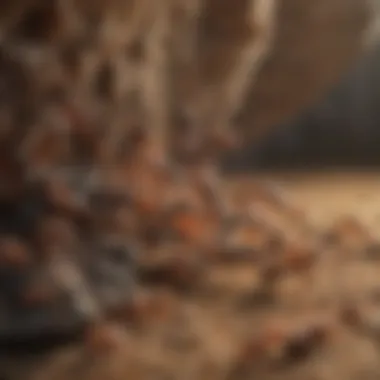

Intro
Ant invasions can turn a peaceful home into a small battleground. For many housewives and homeowners, spotting a single ant can feel like a sign that trouble is lurking around the corner. Once they spot that first intruder, the nagging question seems to bubble up: "Why are they here?" This article sets out to explore the reasons ants invade homes, diving into their biology, behaviors, and how to effectively manage and prevent these tiny invaders from becoming a household headache.
By understanding the reasons behind these infestations, from the specific dietary preferences of different ant species to the environmental conditions that attract them, homeowners can better equip themselves with strategies to maintain their living spaces bee-free. So, whether you’re a meticulous homemaker or someone who simply wants to reduce their pest troubles, this article aims to provide the insights you need.
Understanding the Pest
Identification
Recognizing the type of ant you’re dealing with is the first step toward managing the problem effectively. Various ant species have distinct characteristics, behaviors, and preferences, making them uniquely suited to thrive in different environments. Whether it’s the small, black odorous house ant that leaves a trail of scent behind or the larger carpenter ant known for hollering out wood, every species comes with its own habits and tendencies.
To aid in identification, consider the following:
- Size: Ants can range from 1 to 25 millimeters in length.
- Color: Species vary in shades from black to red or even brown.
- Body Structure: Check for noticeable features like node bumps (two-segmented waist) or elongated mandibles.
Getting to know these traits will arm you with the knowledge to pinpoint your little adversaries and act accordingly.
Life Cycle
Understanding how ants reproduce and grow can further illuminate why they invade homes. The ant life cycle has four primary stages: egg, larva, pupa, and adult. It's fascinating to note that each stage relies heavily on the environmental factors around them, including availability of food and suitable nesting areas.
- Egg Stage: Ants begin as eggs, laid in underground nests or hidden spaces.
- Larva Stage: After hatching, larvae are fed by worker ants until they mature.
- Pupa Stage: In this cocooned form, they undergo transformation before emerging.
- Adult Stage: Once they emerge, the cycle begins anew.
This cycle emphasizes why scouting for food or nesting locations can lead to infestations. If conditions are right, you can bet that ants will make themselves at home, multiplying faster than you can imagine.
Pest Prevention Strategies
Environment Modification
Prevention is where the true battle lies. Tweaking your home environment can deter ants from marching in uninvited. Here are a few effective methods:
- Cleanliness: Keep food sealed and surfaces wiped clean, particularly in the kitchen.
- Moisture Control: Ants are drawn to water sources, so fix leaks and eliminate standing water.
- Landscaping: Trim back plants and trees that are close to the house, as these can provide pathways.
Incorporating these small changes might keep your home feeling fresher and less appealing to these pesky critters.
Physical Barriers
Another strategy involves setting up blockades to thwart their progress. Physical barriers can be simple yet effective. Consider:
- Calking Cracks: Prevent ants from finding their way through small openings around windows and doors.
- Screens: Use fine mesh to cover vents and entry points to keep them at bay.
- Ant Moats: In some cases, a small dish of water can create an impassable barrier for the little intruders.
Implementing these barriers makes it harder for ants to trespass and settle in.
Control Methods
Chemical Control
In an unfortunate turn of events where prevention falls short, chemical solutions may be necessary. Many options are available for targeting different species of ants. Be cautious and informed when selecting these products:
- Baits: Using bait lets ants take poison back to their colonies, effectively cutting the population at its source.
- Sprays: Residual sprays can kill ants on contact and can act as deterrents.
While chemical solutions may provide quick fixes, they should ideally be a last resort, considering the health of family and pets.
Biological Control
Lastly, biological methods can also prove effective. This approach utilizes natural predators or environmentally friendly agents to manage pest populations without chemicals. For instance:
- Beneficial Nematodes: These microscopic worms can help control ant populations in the soil.
- Diatomaceous Earth: A natural powder that desiccates ants upon contact, leading to their demise without harsh chemicals.
These methods can be less harmful to the environment, which is a vital consideration for many homeowners.
Prelims to Ant Infestations
When we think about our homes, we often picture comfort and safety. Yet, there exists an unseen population of creatures that can turn this sanctuary into a battleground—ants. Understanding the nature of ant infestations isn't just about pest control; it's about comprehending the broader implications of these visits into our living spaces. These tiny insects can significantly impact our households, sometimes leading to structural damage or transmitting unpleasant bacteria. The importance of this topic lies in its multifaceted nature, addressing not only the biological and behavioral aspects of ants but also their habitat preferences and the environmental triggers that pull them into our homes.
Being alert to the signs of infestations can save homeowners from extensive damage and costly extermination services. This section will lay the groundwork for recognizing ant behavior, helping readers develop a proactive rather than reactive approach. Knowledge is power, as they say; understanding the specifics surrounding ant infestations can pave the way for effective prevention and control strategies. With this insight, house owners can manage their environments better, ensuring a more harmonious coexistence with these industrious little invaders.
The Nature of Ants
Ants are social insects living in structured communities or colonies. Each species exhibits unique behaviors, societal roles, and preferences that influence their nesting and foraging habits. Ant colonies can range from a few dozen individuals to millions, forming a complex system of communication and division of labor. Their ability to adapt and their sheer numbers are often what lead them to invade homes in search of resources. Understanding these traits allows homeowners to better prepare for and manage infestations.
Common Ant Species Found Indoors
While there are thousands of ant species, only a few are commonly found indoors. Among the most notorious are house ants, carpenter ants, and sugar ants. Each of these species has distinct behaviors and habitats, which play a crucial role in how they interact with human environments.
House Ants
House ants, particularly the Tapinoma sessile, are often found scurrying across kitchen countertops in search of crumbs. They are known for their adaptability and widespread presence in households. One key characteristic of house ants is their ability to thrive on a variety of food sources, including proteins, sugars, and fats. This versatility makes them a frequent visitor to homes, often appearing wherever food is accessible.
What stands out about house ants is their penchant for building colonies in walls or beneath floors, often without drawing much attention. Their size, typically between 1/16 to 1/8 inches, makes them difficult to spot until their numbers have swelled. Their presence can indicate a lapse in cleanliness or food storage methods, rendering them a nuisance and a potential health hazard in the household.
Carpenter Ants
Carpenter ants, or Camponotus, are significantly larger than house ants and are known for their destructive habits. These ants do not eat wood like termites; rather, they excavate it to create their nests. A stark highlight of carpenter ants is their black or bicolored appearance, often ranging from 1/4 to 1/2 inch in length. Their behavior can lead to substantial structural damage, especially in areas like basements and attics where wood is prevalent.
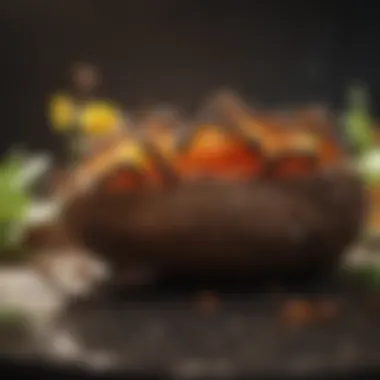

Their attraction to moist or decayed wood makes them a particular concern for homeowners. While they may not be harmful to health, their impact on the integrity of the home is a quite serious matter and should not be ignored. A quick spotting of these carpenter ants may necessitate immediate action to prevent costly repairs.
Sugar Ants
Sugar ants, scientifically known as Camponotus consobrinus, are famed for their sweet tooth. These small, usually less than 1 inch long, ants can dominate the kitchen, drawn in by sugary substances. Their presence often signifies a source of food in the vicinity, which can include spilled juice, unsealed candy, or other remnants of sweetness. A weird characteristic of sugar ants is their tendency to form large foraging trails; once they find a food source, they’ll communicate this discovery to others through pheromone trails.
Sugar ants may not instigate property destruction like carpenter ants, but their scale and persistence make them a common household nuisance. Leaving food unsealed can invite a swarm of these insects into your home quickly, making the learning of effective food storage methods invaluable to the homeowner.
By understanding these common species and their behaviors, house owners can take appropriate steps to deter their unwanted presence. Each type of ant poses unique challenges and threats, and recognizing these can help in formulating strategies to keep them at bay.
Reasons Why Ants Enter Homes
Understanding why ants decide to invade our living spaces is crucial for homeowners and house makers. Ants are not just nuisances; they can also indicate broader environmental issues or attract other pests. By grasping their motivations, one can take proactive steps to minimize and mitigate the risks associated with infestations.
Food Sources
A significant catalyst behind ant invasions is the search for food. This aspect cannot be overlooked as it directly ties into ants’ natural instincts to gather provisions for their colonies.
Common Food Preferences
Ants exhibit a diverse palate, possessing unique preferences that shape their foraging behavior. Many common household foods, like sweets and proteins, tend to attract specific ant species. For instance, sugar ants are drawn to sugary substances, while carpenter ants appreciate proteins found in meats. This characteristic makes food sources particularly vital in understanding their behavior and planning control strategies.
A distinct feature of common food preferences is the ability of ants to communicate food availability through pheromones. Once a scout ant stumbles upon an appealing food source, it leaves a chemical trail, leading back to the colony. As a result, ants communicate the location efficiently, ensuring that resources are shared within the group. This social behavior can turn a minor crumbs situation into a full-blown invasion quite promptly.
Food Storage Tips
To counter the attractions of ants, proper food storage is key. Storing food in tightly sealed containers is an effective way to maintain food freshness while deterring pests. This method not only protects food but also restricts the odorous scents that can attract these insects.
Using air-tight bins for items like cereals, pasta, or grains can keep ants at bay, representing a strategic approach for anyone looking to reduce the chances of an infestation. Unique features of this practice include preventing that unwelcome trail of ants and cutting off their supply chain, thus making your home less inviting for them. However, all this requires diligence, as even the smallest unsealed food source can be their ticket inside.
Shelter and Nesting Preferences
Next, let's consider the nesting behavior of ants, which plays a critical role in why they choose to invade homes. Ants are remarkable in their ability to adapt to different environments, whether it’s a bustling urban area or a natural forest.
Indoor versus Outdoor Nesting
Ants tend to exhibit distinct behaviors when it comes to nesting, having preferences that align with environmental factors. Indoor nesting often occurs when spaces are warm, dry, and sufficiently sheltered from predators and harsh weather. On the flip side, outdoor nesting enables ants to thrive in a more unrestricted habitat, which is easier to manage and find resources.
The unique aspect of indoor nesting is the fusion of both safety and easy access to food, which becomes a prime motivation for some species. However, this also brings disadvantages, as indoor nests can escalate into significant infestations quickly, posing risks for both structural damage and health.
Optimal Conditions for Nesting
The optimal conditions for nesting largely depend on humidity, temperature, and available resources. Each ant species has its specific preferences; some prefer damp wood or areas near water sources, while others favor soil or decaying organic matter. This specificity is crucial for understanding why certain homes become hotspots for particular ant species.
A key benefit of maintaining awareness of these conditions is the ability to micromanage one's living environment. For example, eliminating dampness and ensuring adequate ventilation can create less desirable nesting conditions. This action not only aids in preventing infestations but also encourages a more comfortable living space overall.
Environmental Factors
Environmental factors also play a significant role in the presence of ants in our homes. Changes in seasons and weather patterns can drastically influence ant activity, prompting them to seek new locations for nesting and foraging.
Seasonal Influences
Seasons dictate much of nature's cadence, including that of ants. During warmer months, ants are generally more active as they leave their nests in search for food and mating opportunities. Conversely, in colder months, many species retreat, potentially leading to infestations as they seek the warmth of human dwellings.
This seasonal behavior underscores the importance of preemptive measures during the late spring and early summer. Understanding these patterns can help homeowners anticipate ant invasions before they occur, allowing for more effective management strategies during their most active times, making it a benefit worth acknowledging.
Weather Patterns
Extreme weather variations can also drive ants inside. Heavy rain can wash away outdoor food supplies, prompting them to search for alternatives within human environments. Conversely, dry spells can reduce food availability, leading ants to invade residences that offer accessible nourishment.
The distinctive feature of this behavioral response shows the connection ants have with their surrounding environment. As such, awareness of local weather patterns can empower homeowners to adjust their approaches in tackling potential infestations, allowing them to react to changes in real-time. This insight is invaluable as it merges practical home maintenance with broader environmental awareness.
Ant Behavior and Communication
Understanding ant behavior and communication is critical when tackling invasions in our homes. It sheds light on how these social creatures operate and helps homeowners devise effective strategies to keep them at bay. This section scrutinizes how ants forage for food and communicate with each other, revealing insights that can assist in managing infestations.
Foraging Behavior
Foraging is a natural drive for ants, and it's quite fascinating to observe. When an ant embarks on a quest for food, it may start alone, wandering through the environment and discovering sources like spilled crumbs or pet food. The lonely hunter doesn’t go far without leaving a trail of pheromones—sure, it sounds complicated, but it's simpler than it appears. Pheromones are volatile substances that ants secrete to guide others to resources.
A classic example is the way sugar ants operate. By following these scent trails, other ants can quickly mobilize and swarm around a food source. This method not only saves time but increases the chances of food gathering success. When thinking about it, you might notice similar behavior in your home; if you see one or two ants, it’s often just the tip of the iceberg. If they find something tasty, you can bet more will follow.
To minimize attracting ants through foraging behaviors, it’s crucial to maintain tidiness. Here are some effective tips:
- Seal Food Containers: Store food in airtight containers so the scent doesn't escape.
- Immediate Clean-Up: Clean any spills or food crumbs right after meals.
- Keep Pet Food Covered: If you have animals, ensure their food isn't left out constantly.
Trail Communication
Once an ant finds food, the process continues, and the communication becomes vital. Through trail communication, ants inform their colony about food sources or dangers. By laying down pheromone trails, they can signal their fellow ants to follow, creating a bustling procession towards the discovery.
One unique element of this behavior is the capacity for these trails to evolve. If an ant senses danger along a path—say, a predator or pesticides—it might alter or cease the trail, affecting the whole colony’s movement. Likewise, if a food source proves fruitful, the trail becomes more potent, leading to an increase in foraging trips. This adaptability is remarkable and shows the level of organization within ant communities.
To dissect this behavior further, here's a breakdown of how trail communication works:
- Densely Marked Trails: Ants reinforce busy routes by depositing more pheromones, leading to efficient foraging.
- Learning and Memory: Ants have an impressive memory for their surroundings, helping them navigate through obstacles or alternate routes if necessary.
- Group Decision Making: When finding new food sources or establishing new nests, ants often engage in a group decision process, showcasing their collective intelligence.
"Ants display remarkable teamwork through pheromone trails. The more ants follow a trail, the more it becomes a high-traffic road for foraging."
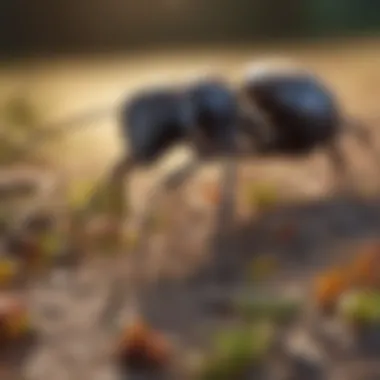
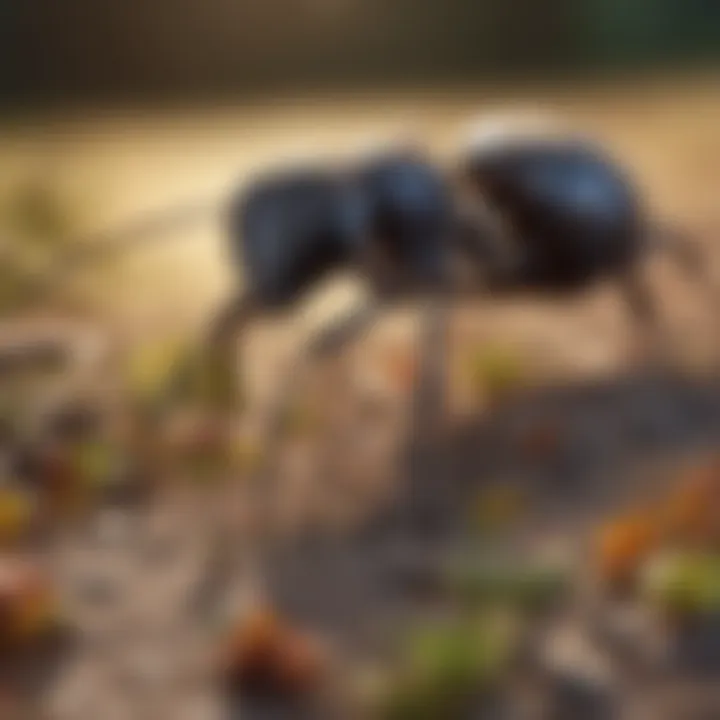
By making sense of their foraging and communication strategies, homeowners can recognize red flags indicating a larger infestation. Keeping an eye on those trails can lead to quicker interventions and preventive actions. In the grander scheme, understanding these dynamics offers us an edge in outsmarting a persistent pest.
Identifying Ant Trails and Nests
When ants invade a home, knowing how to identify their trails and nests becomes crucial for effective management. An understanding of these elements not only aids in locating the source of the infestation but also helps in implementing preventative measures sooner rather than later. This section is about spotting the telltale signs of ants and their nests.
Signs of an Infestation
Recognizing the signs that ants have made their way into your home can be the first step in controlling their population. Ants aren't just wandering in by chance; their presence usually indicates a specific need—often food or shelter.
Physical Signs
Physical signs are tangible clues often found in your living space. These include small piles of tiny particles, perhaps even husk-like remnants, which indicate areas where ants have been busy, especially around their nests. One key characteristic of physical signs is that they are usually easy to spot. For example, if you notice telltale black specks or sawdust-like debris near wooden structures, it may suggest that carpenter ants are active.
Another useful aspect of physical signs is that they serve as markers of active infestations. Often, these marks will be in the vicinity of food sources or nest locations. Finding physical signs can rapidly backtrack the path that ants have taken, and that is notably beneficial for immediate action while figuring out control strategies. However, one disadvantage is that relying solely on these signs doesn’t give you a comprehensive picture; some species make their nests in hidden places, which can lead to misidentifying the problem.
Behavioral Signs
Behavioral signs of ant activity give insight into how ants function and their movements in your home. Watching ants works wonders; for example, spotting a line of ants marching consistently toward a food source is directly indicative of a thriving colony. A key characteristic of behavioral signs is their dynamic nature. Ants communicate through pheromones, often leaving a chemical trail that gets picked up by other ants, which can be observed in a continuous line. This provides firsthand verification of active trails and potential nest locations.
Behavioral signs can also provide critical timing information. For instance, if you notice increased activity at certain times, it may suggest when they are likely to forage, which can be helpful for planning counterstrikes. Although deciphering behavior adds another layer of observation, it can sometimes be misleading if you mistake foraging ants for a venue of an extensive infestation.
Where to Look
Identifying where to look for ant nests enhances your chances of effective control. Most ants prefer specific locations for nesting, and knowing these can save time in your search efforts.
Common Nest Locations
Common nest locations can span a range of environments, often based on the type of ant involved. For example, pavement ants tend to establish their colonies in soil beneath sidewalks or within the crevices of pavement. This key characteristic means that nests can be in seemingly innocuous places. Such information is vital because, for homeowners, nests in external areas might not be initially obvious, even if they are close to the foundation of a house.
Unique features of common nest locations are their various forms. Some ants, like the carpenter ant, might inhabit decaying wood, which introduces added complications if a home is older or in need of repairs. The advantage of knowing these locations is that it can lead to more targeted treatments—eliminating nests can yield quicker results. On the flip side, some nests may remain hidden in places like wall cavities, which makes them harder to reach.
Trail Observation Techniques
Trail observation techniques vary from simple visual surveillance to more complex methods. Watching ants interact provides essential insights into their behavior and routes. One key characteristic of effective trail observation techniques is their versatility; you can often use them with minimal or no tools. Notably, this natural approach lets you determine trails based on where you observe them most frequently, giving practical information about their nesting locations.
Using these techniques, you may take note of time, weather, or other environmental factors affecting trail activity. DIY methods can include placing food items as bait along suspected trail paths for even better identification of trails and nest locations. While this roundabout technique can be revealing, keep in mind, it also has a downside. If not done carefully, one could unintentionally draw even more ants to a bait station.
Observing ants and noting signs of their presence not only helps in identification but is key in strategizing effective ant control measures.
Preventative Measures to Deter Ants
Ant invasions in homes can turn a serene environment into a bustling hub of tiny intruders. Thus, it’s vital to take proactive steps to keep these pests at bay. Preventative measures not only help in reducing the likelihood of an infestation but also ensure that once an invasion occurs, it doesn’t spiral out of control. By emphasizing clean environments and strategic planning both indoors and outdoors, homeowners can create unwelcoming territories for these determined insects.
Home Maintenance Tips
Sealing Entry Points
Sealing entry points is one of the foremost actions to prevent ants from entering your home. More than just a common-sense measure, this step can significantly impact the success rate of your ant prevention efforts. Ants are incredibly skilled at locating cracks, crevices, or even minute openings to access food and shelter. Thus, identifying and sealing these potential entryways is essential. A well-sealed home becomes a fortress against these pests.
Utilizing silicone-based caulking sealants and weatherstripping can bolster the integrity of your living spaces. The characteristic of this method is simplicity; it’s often something a homeowner can do in a single afternoon. An appealing feature of sealing entry points is the long-lasting protection it offers. However, it's essential to regularly inspect these areas, as wear and tear can occur over time.
"A small crack can lead to big problems. Better to fix it early than dealing with a battalion later."
Regular Cleaning Practices
Adopting regular cleaning practices can significantly contribute to reducing the likelihood of attracting ants. This aspect is particularly crucial because ants are drawn to food residues, crumbs, and spills. By maintaining a clean household, you effectively minimize food sources that might attract these little nuisances.
A solid characteristic of effective cleaning is consistency. Sweeping floors, wiping countertops, and regularly taking out the trash will cultivate an environment that is far less appealing to ants. A distinct advantage of this approach is that it benefits household hygiene overall, rather than just targeting pests specifically. One disadvantage to note is that it requires diligent effort, and neglecting cleaning tasks can lead to renewed invasions.
Landscaping for Ant Prevention
Plant Selection
The choice of plants in your garden can significantly influence ant activity around your home. Certain plants are known to deter ants, presenting a natural barrier. For instance, herbs such as mint and rosemary can repel ants due to their strong fragrances. Selecting pest-repelling plants can enhance the natural beauty of your garden while serving a dual purpose of pest control.
One noteworthy characteristic of using plant selection as a preventative measure is that it respects the environment, avoiding harmful chemicals. It also integrates pest control into the aesthetic of your outdoor space. However, maintaining these plants does require care, and some homeowners may find it challenging to keep them healthy.
Yard Maintenance Techniques
Implementing yard maintenance techniques plays a crucial role in ant prevention. Regularly mowing the lawn, trimming branches away from the house, and keeping mulch at a minimum can thwart ants from establishing nests close to your home. This aspect focuses on creating an uninviting habitat for them.
An appealing feature of good yard maintenance is that many of these practices are beneficial for the overall health of your outdoor space. Furthermore, a well-maintained yard often adds to curb appeal. On the downside, some might struggle with the time commitment that regular upkeep demands, particularly in busier households.
Effective Control Strategies for Ants
When facing an ant invasion, it’s crucial to have effective control strategies on hand. Understanding the methods available can lead to successful eradication of these pests, ensuring a healthier and more comfortable home. This section will cover both DIY approaches and the option of professional pest control, providing insights into their pros and cons.
DIY Control Methods
In tackling an ant problem, many homeowners prefer DIY control methods due to their accessibility and cost-effectiveness. These methods can be quite effective, especially during the early stages of an infestation.
Traps and Baits
One popular method involves using traps and baits to manage ant populations. Ant baits work by attracting workers to a poison that they take back to their nest, ultimately targeting the queen and the entire colony. This method effectively disrupts their life cycle.
Key characteristics of traps and baits:
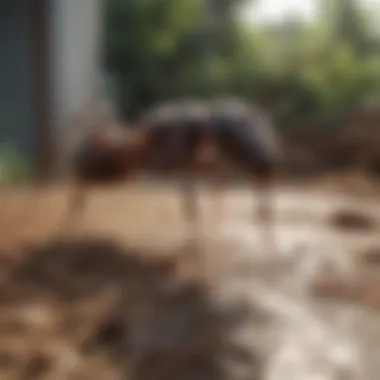
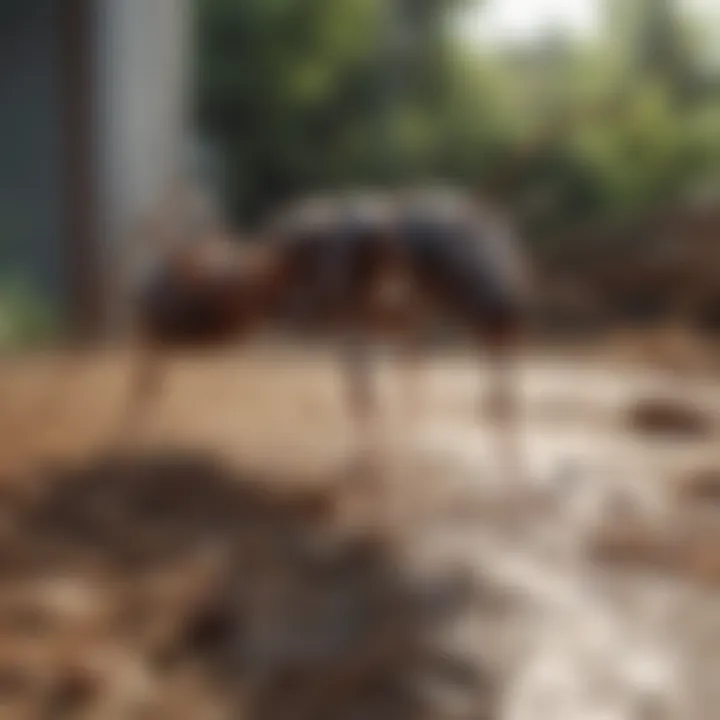
- Targeted Approach: Baits specifically draw ants in and ensure the poison reaches the nest environment.
- Minimal Risk: They are safer to use around children and pets compared to broad-spectrum pesticides.
A unique feature of ant traps is that they often require little setup—just a simple placement in areas frequented by ants. However, baits can take time to show results, which might lead to some frustration for the impatient homeowner.
Advantages of using traps and baits include affordability and ease of access; many generic options are found at local stores. But there's also a downside: not all baits work on every ant species, meaning trial and error might be necessary.
Natural Remedies
Natural remedies have gained popularity as eco-friendly alternatives to chemical solutions. Ingredients like vinegar, diatomaceous earth, or essential oils can be employed to deter ants without harsh chemicals.
Key characteristics of natural remedies:
- Environmentally Friendly: These methods reduce chemical exposure for your family and pets.
- Usually Readily Available: Many common household items can be used.
One unique benefit of natural remedies is that they often repel ants rather than kill them. For instance, vinegar can disrupt the scent trails that ants rely on. While this is useful in preventing further invasions, it may not completely eliminate the existing problem.
Among the advantages of natural solutions are their minimal environmental impact and safety for various domestic settings. However, they may not be as effective as chemical options, particularly in the face of a substantial infestation.
Professional Pest Control Options
If the ant problem escalates beyond DIY methods, considering professional pest control may be your best option. Companies in this field offer experience and a broader arsenal of techniques to handle serious infestations.
Choosing a Pest Control Service
When selecting a pest control service, it’s vital to choose wisely. Look for licensed and insured professionals who offer viable ant control solutions tailored to your specific infestation challenges.
Key characteristics of reputable pest control services:
- Expertise: They possess the knowledge and training to identify different ant species and their behaviors.
- Safety Measures: Professionals are trained to handle pesticides safely, minimizing risk to humans and pets.
Choosing a pest control service also allows the utilization of more potent treatments that might not be accessible to the average homeowner. A significant advantage here is that they can effectively address deeper infestations, giving you peace of mind. However, costs can be a consideration, as hiring professionals typically involves more investment than DIY methods.
What to Expect from Professionals
When you engage a pest control service, you can expect a thorough assessment of your home. This process typically involves the following:
- Inspection: Understanding the extent of the ant problem.
- Treatment Plan: Developing a customized approach to eliminate the threat.
- Follow-Up: Many services provide follow-up visits to ensure the effectiveness of the treatment.
Key characteristics of professional services:
- Comprehensive Solutions: They often provide integrated pest management techniques.
- Long-Term Results: A professional approach aims for sustainable management rather than quick fixes.
The unique feature of hiring professionals is the tailored approach they provide. Unlike over-the-counter options, their treatment is based on specific conditions of your environment and the species they’re dealing with.
Among the advantages of professional pest control are expertise, thoroughness, and the ability to handle more challenging situations. On the downside, the financial factor can deter some homeowners from seeking such services. It’s essential to weigh your options and consider both immediate and long-term impacts related to ant infestations.
Ultimately, both DIY methods and professional pest control services can effectively manage ant invasions. The choice between them depends on your specific situation, preferences, and budget.
Identifying and Responding to Specific Challenges
Understanding how to identify and respond to specific challenges posed by different ant species is vital for effective ant management in the home. The ability to differentiate between species such as carpenter ants and sugar ants enables homeowners to tailor their approaches, ensuring they tackle the problem at its root rather than merely addressing symptoms. Each ant type comes with its own set of behaviors, risks, and preferences, making this knowledge crucial for anyone looking to maintain a pest-free environment.
Addressing these specific challenges not only protects one's property but also preserves the peace of mind that comes with knowing the home is safe. In dealing with different species, homeowners can employ more effective strategies, reduce potential damage, and minimize unnecessary expenses. This section aims to impart insights into effective tactics for both carpenter ants and sugar ants, ensuring readers are well-armed against an invasion.
Dealing with Carpenter Ants
Carpenter ants can be a significant concern due to the damage they can inflict on wooden structures. Unlike termites, which consume wood, carpenter ants excavate it to create nesting sites. This behavior can dramatically weaken the integrity of wooden beams, making early detection and intervention crucial. Here are some essential strategies for dealing with carpenter ants:
- Inspection: Regularly check for signs of activity in areas such as attics, basements, and behind walls. Look for wood shavings or frass, which often accompany nests.
- Eliminate Moisture: Carpenter ants are drawn to damp wood. Fix any leaks and ensure proper drainage around your home to create a less inviting environment.
- Seal Entry Points: Inspect your house for gaps around windows, doors, and utility lines. Sealing these openings can prevent ants from entering.
- Remove Food Sources: Keep food stored in airtight containers and ensure crumbs are promptly cleaned up.
- Employ Baits and Traps: Use bait stations designed for carpenter ants. These can be highly effective if placed near identified trails.
Remember, if the infestation appears severe or if structural damage is present, it’s wise to consult a pest control professional.
Managing Sugar Ants
Sugar ants, or Nodbonus spp., have a penchant for sweet substances but can also be attracted to protein and grease, making kitchens a prime target. Managing these ants requires vigilance and a multifaceted approach:
- Sanitary Practices: The first line of defense against sugar ants is cleanliness. Maintain counters free from sticky residues and ensure dishes are cleaned promptly.
- Secure Food Storage: Keep items like sugar, honey, and snacks in sturdy containers that ants cannot penetrate.
- Deter Entry: Inspect your home for cracks and gaps, covering them where possible to minimize access points.
- Use Natural Deterrents: A solution of vinegar and water can disrupt ant trails, serving as both a repellent and a cleaning agent when wiped in entry spots.
- Identify and Destroy Nests: If you locate a nest, consider using targeted insecticide or natural options, like diatomaceous earth, to manage their populations effectively.
"An ounce of prevention is worth a pound of cure." This adage underlines the importance of proactive measures against sugar ants.
By understanding and recognizing the particular nuances of carpenter and sugar ants, homeowners can better prepare to fend off an invasion, ensuring their living environments remain comfortable and intact.
Culmination
In closing this article, we shed light on the various threads that weave together the fascinating world of ants and their often unwelcomed visits to our homes. Recognizing the reasons behind these invasions is crucial not only for effective management but also for understanding the ecology that surrounds us. Ants, despite their tiny stature, play significant roles in our environment, from soil aeration to pest control. However, their presence in our living spaces can sometimes lead to discomfort and inconvenience.
Summarizing Key Points
To succinctly recap what we’ve explored:
- The Nature of Ants: These creatures are highly social insects that form colonies, making them incredibly efficient in their foraging and nesting behaviors. Understanding their biology helps in grasping why they invade homes.
- Reasons for Invasion: The factors that pull ants into our homes generally include the search for food, suitable nesting locations, and favorable environmental conditions. Each species responds differently based on these factors.
- Ant Behavior: Understanding how ants communicate and forage provides insight into how to identify and respond to infestations.
- Identification and Prevention: Knowing how to spot their trails and nests is the first step in dealing with an ant problem. Preventative measures, such as home maintenance and landscaping, are vital in deterring them.
- Control Strategies: Effective methods—both DIY and professional—can significantly reduce ant populations. Recognizing specific challenges, like those posed by Carpenter and Sugar ants, helps tailor more effective responses.
Final Thoughts on Coexistence with Ants
While managing ants might seem like a chore, there's also a perspective that encourages coexistence. Recognizing the ecological benefits that ants bring can help foster a balanced approach. For homeowners, this could mean taking preventive steps that allow ants to thrive outdoors while keeping our spaces safe and clean.
Moreover, adopting a mindset of coexistence involves:
- Learning: Understanding and respecting the role of ants in our ecosystem can pave the way for more informed decision-making.
- Adaptation: Finding ways to coexist with ants while minimizing their impact on our lives often requires creativity in prevention and control measures.
- Observation: By keeping an eye on their behaviors and habitats, we can prevent infestations before they escalate.
"By understanding ants and their habits, we not only learn about pest control but also about nature itself."
Ultimately, a well-informed and thoughtful approach can pave the way for a harmonious relationship with these tiny yet influential creatures.







